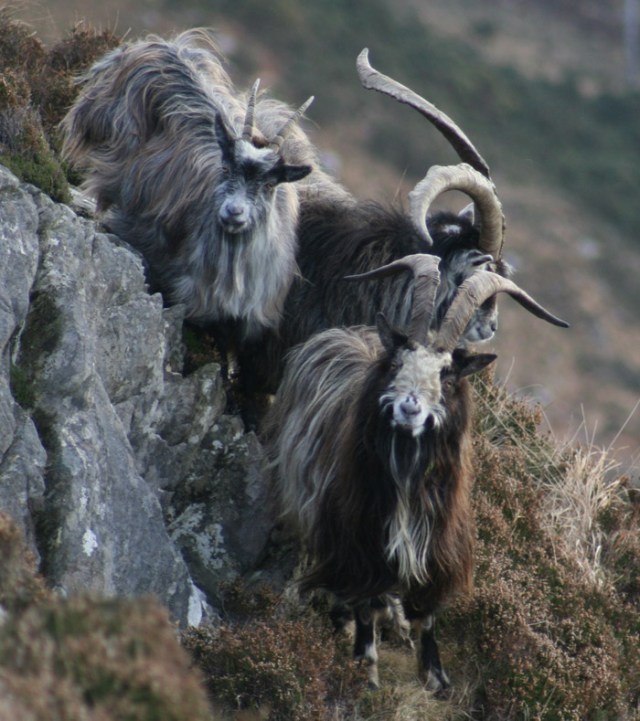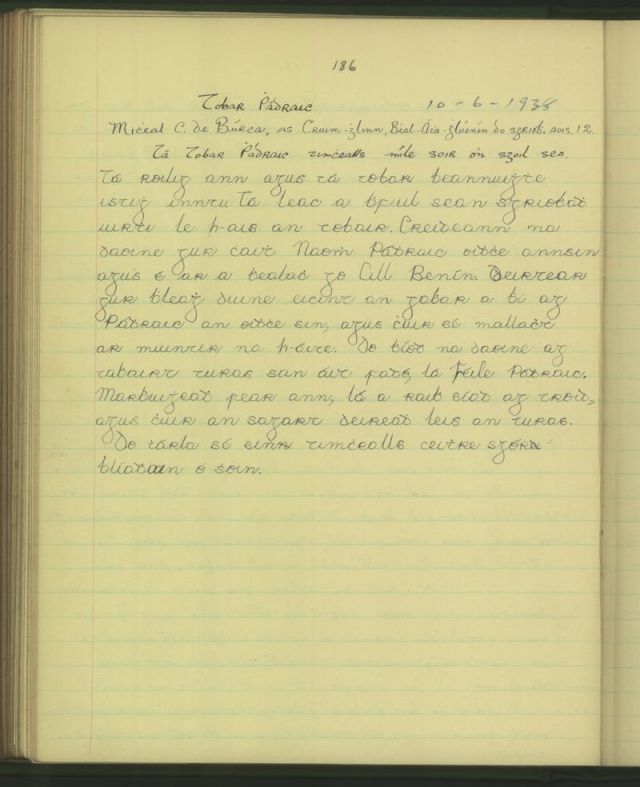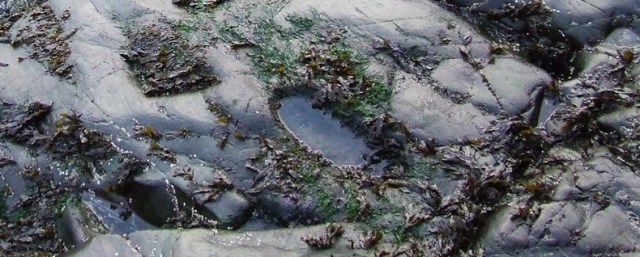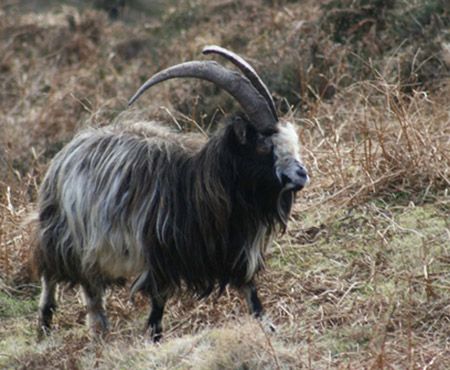I cant believe that I have reached number eight in my series of blog posts on the Irish saints and their animals. St Patick has previously featured with his miraculous cow and he makes an appearance again on account of his association with a magical goat. I’m very grateful to Christy Cunnliff the Galway Archaeological Field Officer for telling me about this story. Christy also writes the Galway Community Archaeology Blog.

Group of wild Irish Goats Image taken from http://www.oldirishgoatsociety.com/
As far as I know the story of St Patrick and his goat occurs in folklore in only two areas of Ireland, Co Galway and Co Dublin. If anyone has come across this story or variation of it elsewhere in the country Id be delighted to hear from you.
The story of St Patrick and His Goat from Co Galway
St Patrick and his goat appear in the folklore of east Co Galway in the parish of Abbert/Monivea. The saint is associated with a small holy well-known as Tobar Padraig (St Patrick’s holy well) located in Monivea parish graveyard.

Tobar Phadraig Monieva Co Galway
According to tradition St Patrick rested at the well and baptised the local people, indeed a rock at the side of the well with a slight depression is said to have been created by the saint when he knelt beside the well (Cunniffe 2016, 3). The holy well was once a place of pilgrimage and a large pattern day took place on the feast of the saint. The wall surrounding the well has a plaque dating to 1688 that depicts the saint standing on a serpent. Over time devotions waned but the well is still visited by a small number of people.
In another tale from the area when St Patrick arrived to the area he was accompanied by a goat. The Schools Collections recorded in the late 1930’s mentions two versions of this tales. In both tales milk is stolen from the goat and the saint places a curse on the area.
The Schools Collections for the parish of Crumlin records that
Patrick’s Well is a mile east of this school. There is a graveyard there and a blessed/holy well in it. Next to the well there is a stone/flagstone which has old writing on it. The people believe that St Patrick spent the night there on his journey to Cill Benín. It is said that someone milked a goat that St Patrick had with him that night and he cursed the people of the area. People would travel there long ago on St Patrick’s Day. There would be fighting and the priest put an end to these travels/pilgrimage. This happened about 80 years ago ( Crumlin School, The Schools’ Collection, Volume 0082, Page 186 translated from Irish by Paul Devane).

Crumlin School, The Schools’ Collection, Volume 0082, Page 186
A second version of the tale was also recorded in the Schools Collection at Kiltullagh
When St. Patrick was in Ireland long ago. One day he was travelling through Monivea and he had a Goat with him. He went into the church to pray, and whilst he was inside somebody in Monivea milked the Goat. St. Patrick was vexed, and when he was leaving Monivea he looked back and said that he hoped Monivea would be neither better or worse. So Monivea stands the very same way ever since and it is not better or worse (The Schools’ Collection, Volume 0034, Page 0475 Kiltullagh, Co. Galway).
St Patrick and His Goat in Co Dublin
A variant of the tale is found on the east coast of Ireland in North Co Dublin at Skerries.
According to legend St Patick spent time in Skerries Co Dublin, and his presence in the area is remembered by a hollow in rock on the seashore which is called St Patrick’s footprint. According to local legend
When St. Patrick was expelled from Wicklow by the pagan natives he sailed northwards and landed on a small island off Skerries, which is now known as St. Patrick’s Island in his honour. When the saint arrived on this island he had with him a goat, which was his companion and source of milk.
From this island St. Patrick came to the mainland to convert the local people. While St. Patrick was ashore on one of these visits some people from Skerries went out to the island and stole his goat. They killed the goat, cooked it and feasted on it. When St. Patrick went to the island he found his goat missing.
This made him very angry and in two giant strides he reached the mainland. The first step took him to the back of Colt Island and the second to Red Island, where he confronted the people of Skerries.
When they tried to deny interfering with his goat they found they could only bleat. When they were prepared to tell the saint the truth their voices returned. Where St. Patrick stepped onto Red island his footprint is to be seen in the rock to this day. Since then the nickname Skerries Goats is given to the people of the town to remind them of this deed (http://www.skerriesparish.ie/history).

St. Patrick’s footprint can be seen on the rocks near the Springboards, the tidal bathing place on Red Island image taken (https://m0.herfamily.ie/wp-content/uploads/2015/03/13140617/print.org
The Schools Collections for Holmpatrick notes
In Skerries there is a bathing place called the “Spring Board”
In one of the rocks there is a hole in the shape of a man’s foot-print .
The people of skerries say it is the foot-print of St, Patrick; that when he was on one of the Island he stepped over to the mainland , where the “Spring Board” are now
This story is told by all the inhabitants of Skerries. (The Schools’ Collection, Volume 0784, Page 91 Holmpatrick (roll number 14180)Bronze Plaque to St Patrick’s Goat at Skerries Church image taken http://irishheraldry.blogspot.ie/2015/05/heraldry-at-skerries-holmpatrick.html
The blessed Patrick has a goat, which carried water for his service; and to this the animal was taught, not any article but rather by a miracle. And a certain theif stole the goat, and eat, and swallowed it. And the author or instigator or the theft is enquired: and one who by evident tokens had incurred suspicion, is accused; but not only denieth he the fact, but adding perjury unto theft, endeavoreth he to acquit himself by an oath. Wondrous was the event to be told, yet more wonderful to come to pass. The goat which was swallowed in the stomach of the thief bleated loudly forth, and proclaimed the merit of Saint Patrick. And to the increase of this miracle it happened, that at the command, nay rather at the sentence of the Saint, all the posterity of this man were marked with the beard of a goat (http://www.gutenberg.org/files/18482/18482-h/18482-h.htm#chap6148).
And Patrick blessed the Assembly of Telltown, so that no one should ever be killed there at, and that only one should be killed at Rath Airthir, and he left his altar a Domnach Patraic. And Patrick went from thence into the territory of Ui Meith in Mendait Tire, and he tarried not in Armagh at that season, and he left holy elders of his people at Tech-talai. Then three of Ui Meith Mendait Tire stole (and ate) one of the two goats that used to carry water for Patrick, and came to swear a lie. It bleated from the bellies of the three. ‘My debroth’ said Patrick, ‘the goat himself hides not the stead wherein he is.’He afterwards went to the men of Bregia and mightily preached the word of God unto them, and baptized and blessed them.
It’s fascinating to see how the story of St Patrick and his goat has survived and adapted through the centuries before becoming established in the folklore of East Galway and North Co Dublin.
As an aside while looking into the story I came across the Old Irish Goat Society
The main aim of the Society is to preserve and promote the Old Irish goat, the original and only landrace breed of goat in Ireland. The society was formed in October 2006, by a small group of enthusiasts who realized that the breed was rapidly heading towards extinction, but that its gene pool could be preserved if assertive action were taken.

To find out more about the old Irish Goat and conservation efforts check out the society website.
References
Cunniffe, C. 2016. Tobar Padraig Holy Well , A Significant Local Pilgrimage Site. Galway Community Archaeology Advisory Project Heritage Week August Unpublished Report.
O’Leary, J. 1874. The Most Ancient Lives of Saint Patrick: including the Life by Jocelin, Hitherto Unpublished in America, and His Extant Writings. Illustrated with the Most Ancient Engravings of Our Great National Saint; With a Preface and Chronological Table. New York: P. J. Kenedy, No. 5 Barclay Street.
Schools’ Collection, Volume 0784, Page 91Holmpatrick, Co Dublin (https://www.duchas.ie)
Schools’ Collection, Volume 0034, Page 0475 Kiltullagh, Co. Galway(https://www.duchas.ie)
Schools’ Collection, Volume 0082, Page 86 Crumlin School, Co Galway(https://www.duchas.ie)
Stokes, W. (ed). 1877. Three Middle-Irish Homilies on the Lives of Saints Patrick, Brigit and Columba. Calcutta : [s.n.].http://celt.ucc.ie/published/T201009/index.html.
http://irishheraldry.blogspot.ie/2015/05/heraldry-at-skerries-holmpatrick.html
http://www.skerriesparish.ie/history.htm



Great stuff. For what its worth, from an early medieval theological perspective, I think the goat motif is an early Irish play on Old Testament symbolism (Particularly Leviticus and Numbers) where goat(s) play a large role as sin offerings for (inadvertent) transgressions. ie. Patricks goat acting as metaphorical vehicle for pagans who ‘know not what they do’.
Hi thanks so much for sharing your thoughts, your on to something there for certain, its all very interesting stuff 🙂
[…] über Holy Cows. The Miraculous Animals of the Irish Saints: Part 8, St Patrick and his Goat — Pilgrimag… […]
Reblogged this on Irish history, folklore and all that.
[…] Source: Holy Cows. The Miraculous Animals of the Irish Saints: Part 8, St Patrick and his Goat […]
[…] To find out more about the folklore connected to the well see Pilgrimage in Medieval Ireland’s blog post HolyCows, The Miraculous Animals of the Irish Saints: Part 8, St Patrick and his Goat. […]
[…] Holy Cow. The Miraculous Animals of the Irish Saints: Part 8, St Patrick and his goat […]